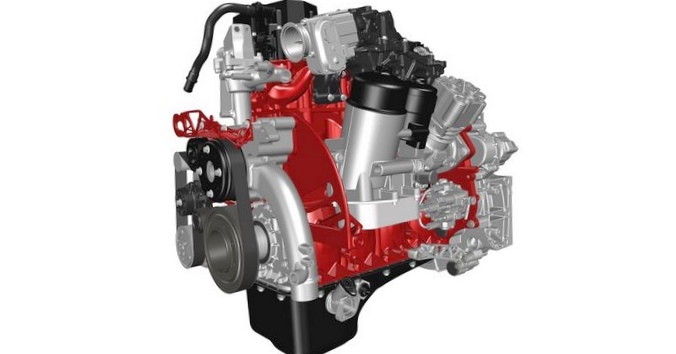Благодаря 3D-печати двигатель Renault стал на 25% легче
Подразделение разработки силовых агрегатов компании Renault Trucks в Лионе представило прототип 4-цилиндрового дизельного двигателя DTI 5. Данный мотор необыкновенен тем, что кое-какие из его железных компонентов напечатаны на 3D-принтере.
Инженеры Renault Trucks должны были оценить перспективность применения 3D-печати железных изделий при изготовлении двигателей внутреннего сгорания. Разработка разрешает слой за слоем вырабатывать подробности сложной формы, наряду с этим уменьшается расход исходных материалов, значительно уменьшается число операций по сборке и обработке, и оптимизируется форма компонентов.
Для экспериментального силового агрегата DTI 5 (класс экологичности Евро-6) по новым техпроцессам изготовили 200 подробностей. В частности, на принтере напечатали часть кронштейна генератора (на 18% легче серийного аналога), держатель проводов (-42%), крышки подшипников распредвала (-36%), коромысла (-36%), и 80 подробностей блока цилиндра, 45 компонентов головки блока цилиндров и другие подробности.
Итоговый итог: понижение неспециализированной массы двигателя на 120 кг (-25%). Мотор удачно прошел стендовые опробования, каковые продолжались 600 часов.
Слева продемонстрирован серийный двигатель Renault Trucks DTI5 Euro 6. Справа – подобный силовой агрегат с напечатанными по новой разработке подробностями (выделены красным).
Не обращая внимания на очевидные преимущества новая разработка до тех пор пока ещё через чур «сырая» для внедрения в серийное производство, выделили в Renault. В кратковременной возможности новые технологические процессы смогут быть использованы для выпуска малых партий подробностей либо под своеобразные заказы. Исходя из хорошего опыта с экспериментальным двигателем DTI 5, разработчики французской компании продолжат изучения в данном направлении.
Продемонстрировать пресс-релиз Скрыть
A team of Renault Trucks engineers and designers is working on an additive manufacturing process — metal 3D printing — that is set to boost the performance of engines. Technology of the future is fast becoming a reality, as can be seen from the complex parts that have already been successfully tested inside a Euro 6 engine.
The Renault Trucks Lyon Powertrain Engineering department has focused on using metal additive manufacturing as a future engine manufacturing process. A prototype DTI 5 4- cylinder Euro 6 step C engine has been designed exclusively using 3D printing.
Although the complete engine was already designed virtually, rocker arms and camshaft bearing caps were manufactured by metal 3D printing and successfully bench-tested for 600 hours inside a Euro 6 engine. "The aim of this project is to demonstrate the positive impact of metal additive manufacturing on the size and weight of an engine. This process has enabled us to reduce the weight of a 4-cylinder engine by 120 kg or 25%", explained Damien Lemasson, project manager at Renault Trucks. "The tests we have carried out prove the durability of engine components made using 3D printing. It’s not just cosmetic."
Metal additive manufacturing opens up new development opportunities for thermal engines. This printing process, which works by adding materials layer after layer, can be used to create complex organic forms, as well as optimizing the sizing of parts and reducing the number of assembly operations and therefore the number of components in an engine. "Additive manufacturing releases us from constraints and unlocks the creativity of engineers.
This procedure is a source of disruptive technology for the engines of tomorrow, which will be lighter and more functional, thereby offering optimal performance," Damien Lemasson added. The number of components in the DTI 5 engine has been reduced by 25%, making a total of 200 fewer parts.
For haulage companies, metal 3D printing carries a number of advantages. They will be able to optimize the overall operating costs of their fleet of vehicles, as a reduction in engine volume will lead to greater payloads and lower fuel consumption.
In the short-term, this manufacturing procedure can be used for highly specific applications or small runs. Following on from these successful initial tests, engineers at Renault Trucks will be continuing their work on this manufacturing process to further increase the performance and functionality of truck components.
Теги: renault производители машин видео двигатель новые разработки
Благодаря 3D-печати двигатель Renault стал на 25% легче
Записи по принципу Рандом:
- Самый недорогой bmw x5 попросит всего 5,6 литра на сотню
- Volkswagen продемонстрировал электрический фургон crafter
- Мвд назвало самые угоняемые марки машин
- Новый «кашкай» возьмёт салонное зеркало с экраном
- первый тест и Презентация skoda rapid
- Назван самый популярный автомобиль мира в 2014 году
самые интересные для Вас статьи, подобранные по важим запросам:
-
С доработками polestar xc90 стал замечательнейшим volvo в истории
С доработками Polestar XC90 стал замечательнейшим Volvo в истории За седаном Volvo S90 и универсалом V90 ателье Polestar выпустило пакет оптимизации для…
-
Стали дешёвы фото рестайлингового renault duster
Стали дешёвы фото рестайлингового Renault Duster Компактный кроссовер Renault Duster, взявший высокое признание российского автомобилиста,…
-
Touareg с дизельными двигателями стал дешевее
Touareg с дизельными двигателями стал дешевее С первого августа и в будущем самые популярные в Российской Федерации дизельные предположения Volkswagen Touareg будут…
-
Танковые двигатели налегковых машинах: легко!
Танковые двигатели налегковых машинах: легко! На заходной иллюстрации самый прекрасный из аналогичных шедевров — Blastolene Indy Special, созданный Рэнди…
-
Трехцилиндровый двигатель ford…
Трехцилиндровый двигатель Ford EcoBoost сможет становиться двухцилиндровым Кроме презентации хэтчбека Fiesta нового поколения компания Ford поведала…
-
Новый renault master – надежный двигатель вашего бизнеса
Новый Renault Master – надежный двигатель Вашего бизнеса Renault в Российской Федерации воображает новый Renault Master, премьера которого прошла в апреле 2014…
-
Renault воображает две автоматические…
Renault воображает две автоматические трансмиссии для Logan, Sandero и Sandero Stepway Renault воображает новую роботизированную пятиступенчатую…

